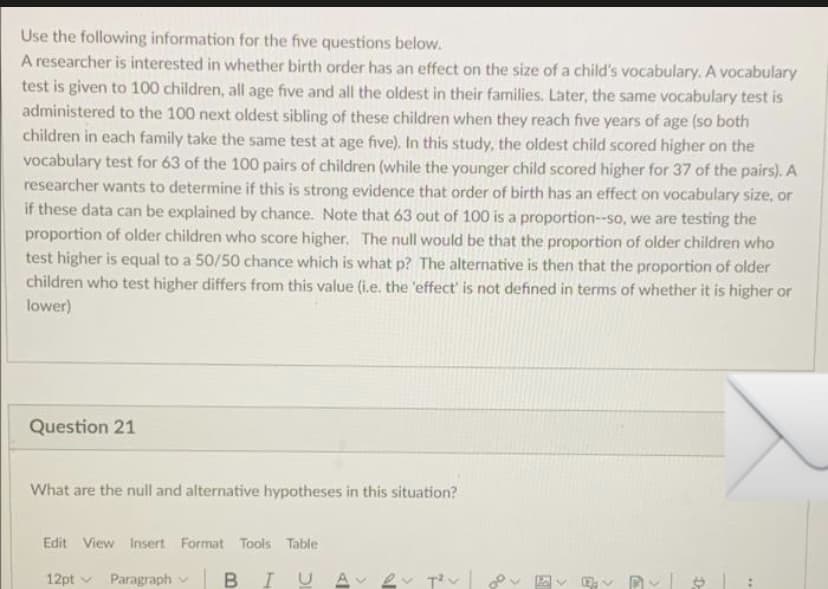Use the following information for the five questions below. A researcher is interested in whether birth order has an effect on the size of a child's vocabulary. A vocabulary test is given to 100 children, all age five and all the oldest in their families. Later, the same vocabulary test is administered to the 100 next oldest sibling of these children when they reach five years of age (so both children in each family take the same test at age five). In this study, the oldest child scored higher on the vocabulary test for 63 of the 100 pairs of children (while the younger child scored higher for 37 of the pairs). A researcher wants to determine if this is strong evidence that order of birth has an effect on vocabulary size, or if these data can be explained by chance. Note that 63 out of 100 is a proportion--so, we are testing the proportion of older children who score higher, The null would be that the proportion of older children who test higher is equal to a 50/50 chance which is what p? The alternative is then that the proportion of older children who test higher differs from this value (i.e. the 'effect' is not defined in terms of whether it is higher or lower) Question 21 What are the null and alternative hypotheses in this situation?
Use the following information for the five questions below. A researcher is interested in whether birth order has an effect on the size of a child's vocabulary. A vocabulary test is given to 100 children, all age five and all the oldest in their families. Later, the same vocabulary test is administered to the 100 next oldest sibling of these children when they reach five years of age (so both children in each family take the same test at age five). In this study, the oldest child scored higher on the vocabulary test for 63 of the 100 pairs of children (while the younger child scored higher for 37 of the pairs). A researcher wants to determine if this is strong evidence that order of birth has an effect on vocabulary size, or if these data can be explained by chance. Note that 63 out of 100 is a proportion--so, we are testing the proportion of older children who score higher, The null would be that the proportion of older children who test higher is equal to a 50/50 chance which is what p? The alternative is then that the proportion of older children who test higher differs from this value (i.e. the 'effect' is not defined in terms of whether it is higher or lower) Question 21 What are the null and alternative hypotheses in this situation?
Algebra: Structure And Method, Book 1
(REV)00th Edition
ISBN:9780395977224
Author:Richard G. Brown, Mary P. Dolciani, Robert H. Sorgenfrey, William L. Cole
Publisher:Richard G. Brown, Mary P. Dolciani, Robert H. Sorgenfrey, William L. Cole
Chapter2: Working With Real Numbers
Section2.3: Rules For Addition
Problem 7P
Related questions
Question

Transcribed Image Text:Use the following information for the five questions below.
A researcher is interested in whether birth order has an effect on the size of a child's vocabulary. A vocabulary
test is given to 100 children, all age five and all the oldest in their families. Later, the same vocabulary test is
administered to the 100 next oldest sibling of these children when they reach five years of age (so both
children in each family take the same test at age five). In this study, the oldest child scored higher on the
vocabulary test for 63 of the 100 pairs of children (while the younger child scored higher for 37 of the pairs). A
researcher wants to determine if this is strong evidence that order of birth has an effect on vocabulary size, or
if these data can be explained by chance. Note that 63 out of 100 is a proportion--so, we are testing the
proportion of older children who score higher. The null would be that the proportion of older children who
test higher is equal to a 50/50 chance which is what p? The alternative is then that the proportion of older
children who test higher differs from this value (i.e. the 'effect' is not defined in terms of whether it is higher or
lower)
Question 21
What are the null and alternative hypotheses in this situation?
Edit View Insert Format Tools Table
12pt v
Paragraph v
BIU A 2v T? v
Expert Solution
This question has been solved!
Explore an expertly crafted, step-by-step solution for a thorough understanding of key concepts.
This is a popular solution!
Trending now
This is a popular solution!
Step by step
Solved in 2 steps

Recommended textbooks for you

Algebra: Structure And Method, Book 1
Algebra
ISBN:
9780395977224
Author:
Richard G. Brown, Mary P. Dolciani, Robert H. Sorgenfrey, William L. Cole
Publisher:
McDougal Littell


Algebra: Structure And Method, Book 1
Algebra
ISBN:
9780395977224
Author:
Richard G. Brown, Mary P. Dolciani, Robert H. Sorgenfrey, William L. Cole
Publisher:
McDougal Littell
